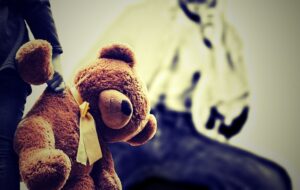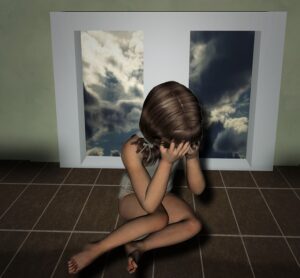
It is never easy to deal with child abuse, but it is important to be as knowledgeable as possible about it in order to help victims and prevent future abuse.
There are many different psychological aspects of child abuse that can be quite complex and difficult to understand.
However, gaining an understanding of these concepts can be helpful in both providing support to victims and in identifying abuse.
One of the most important psychological concepts related to child abuse is the idea of dissociation.
Dissociation is a defense mechanism that can be used to protect people from emotional pain.
It occurs when a person disconnects from their thoughts, feelings, or memories.
This can be done consciously or unconsciously, and it allows people to avoid uncomfortable or traumatic experiences. Dissociation can be helpful in the short term, but it can also have negative consequences in the long term.
For example, people who dissociate frequently may have difficulty forming relationships and feeling connected to others. They may also have trouble remembering important aspects of their lives.
The cycle of abuse
One of the most important psychological concepts to understand about child abuse is the cycle of abuse. This cycle describes the way that abusive patterns tend to repeat themselves over time.
It typically involves three phases: tension-building, explosive anger, and calm/honeymoon phase.
Tension-building phase
During the tension-building phase, the abuser will start to become irritable and angry. This may be accompanied by verbal abuse, threats, or emotional manipulation.
The explosive anger phase is the most dangerous one, as it is when the abuser may resort to physical violence or threats of violence.
Explosive anger
The next part of this cycle that you should be aware of is specifically for child abusers.
In some cases, child abusers will use physical violence against their victims during both the tension-building and explosive anger phases.
However, they are more likely to use manipulative tactics rather than physical violence during the honeymoon phase in order to convince their victims that they are not abusers.
Calm/honeymoon phase
The calm/honeymoon phase is the aftermath of the explosive anger phase.
During this time, the abuser may apologize or try to make up for their behavior.
This can be quite confusing and manipulative for the victim, as it may seem like things are getting better when they really aren’t.
The calm/honeymoon phase is a brief period of time after the abuse has occurred in which the abuser may seem apologetic and kind.
This phase is sometimes used to convince the victim that he or she is actually a good person who made a mistake, rather than an abuser.
Child abuser symptom

Cognitive dissonance
Another important psychological factor to be aware of is how child abusers tend to disassociate themselves from the abuse after it has occurred.
This phenomenon is often known as cognitive dissonance.
It occurs when there is a discrepancy between a person’s actions and their beliefs or values.
Child abusers may be able to disassociate themselves from the abuse by convincing themselves that the victim was actually deserving of the abuse, that they deserved it because they were bad, or that they needed to be punished.
This can be very damaging to victims, as it can leave them feeling like they are responsible for the abuse or that they did something wrong.
Self-blame
Self-blame is another common symptom of child abuse.
Victims may blame themselves for what happened, even though there was nothing they could have done to prevent it from happening.
Self-blaming thoughts are typically formed during childhood and can be reinforced by the abuser.
Suicidal ideation
Children who are abused are more likely to suffer from suicidal thoughts and behaviors in adulthood.
As with self-blame, children are generally not taught the necessary skills to cope with abuse on their own.
This leaves abuse victims especially vulnerable to developing suicidal ideation or attempting suicide in adulthood, especially if they have mental health issues or substance use disorders.
The effects of the child abuse
It is also important to be aware of the different psychological effects that child abuse can have on victims.
Some of the most common ones include post-traumatic stress disorder (PTSD), depression, anxiety, and low self-esteem. Victims of child abuse may also have difficulty trusting others and forming relationships.
They may also be more likely to engage in self-harming behaviors or become addicted to drugs or alcohol.
It is important to remember that abuse is never the victim’s fault.
No one deserves to be abused, no matter what. If you or someone you know is a victim of child abuse, please don’t hesitate to seek help.
There are many resources available, and there is no shame in seeking help. You are not alone.
Child abuser treatment

There are no known ways to “cure” an abuser, but there are several treatment options that may be helpful.
These include cognitive-behavioral therapy (CBT), which can help abusers recognize their thoughts and feelings toward the victim, family therapy, which may improve communication skills within the family, psychoeducation for abusers or victims, and anger management therapy, which can help abusers control their emotions.
Child abusers may also benefit from substance abuse treatment or mental health counseling if they struggle with other disorders that coincide with child abuse.
Treatment is especially important for child abusers who are parents because it provides them with the skills needed to interact with their children in a healthy manner.
- See also: A psychological wellness profile of people with a healthy personality type
- See also: The psychology of hope: how to create optimism and a better future
Child abuse and addiction
Child abusers are more likely to also struggle with substance use disorders.
They may also have additional mental health diagnoses such as depression or anxiety.
The presence of these other disorders can make it more difficult for abusers to remain sober or abstinent, especially if they do not receive the proper treatment.
It is important that anyone who struggles with child abuse and addiction seek treatment for both disorders to improve their chances of recovery.
Child abuse (also child maltreatment) is any act or series of acts of commission or omission by a parent or other caregiver that results in harm, the potential for harm, or the threat of harm to a child.
This broad definition will sometimes include neglectful acts, such as a failure to provide adequate food, clothing, or medical care when needed.
Child abuse can include acts of violence such as striking, beating, kicking, shaking, biting, strangling and suffocating.
In some countries, evidence from child abuse may be used in cases of infanticide. In many jurisdictions, there are specific laws against child abuse that may differ from the general legal definition of assault and battery.
Conclusion
By understanding the psychology of child abuse, you can play a vital role in both providing support to victims and preventing future abuse.
It is important to remember that abuse is never the victim’s fault and that there are many resources available for victims of child abuse.
If you or someone you know is a victim of child abuse, please don’t hesitate to seek help. You are not alone.
No matter what the psychological effects of child abuse may be, one thing remains clear: child abuse is never the victim’s fault.
It is important to remember this, especially when supporting victims of child abuse. There are many resources available for victims of child abuse, and help is always available. You are not alone.
If you or someone you know is struggling with child abuse, please don’t hesitate to seek help. Treatment is available and there is no shame in seeking help. You are not alone.



